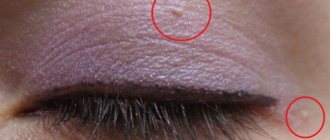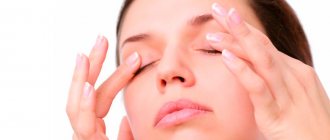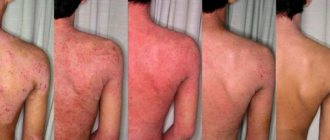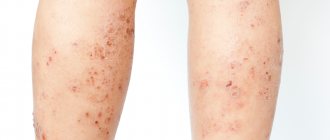Blepharitis is an inflammatory disease of the eyelids that often affects a child's eyes. This can easily be explained by the lack of correct understanding of hygiene in young children, but such a disease can also be caused by other reasons.
In children, blepharitis very often occurs in a chronic form, and treatment of this type of disease requires the immediate intervention of specialists, since the lack of necessary measures can lead to various complications.
How does blepharitis occur - the first symptoms of the disease
The health of a child’s eyes largely depends on the hygiene skills he has learned, the state of his immunity, and his tendency to allergies of various origins.
In this article
- How does blepharitis occur - the first symptoms of the disease
- Blepharitis in children - why is it dangerous?
- Why does blepharitis appear in a child?
- Types of blepharitis
- Purulent blepharitis: symptoms and treatment
- How to cure seborrheic blepharitis?
- Folk remedies for treating blepharitis
- Seborrheic blepharitis - prevention
Seborrheic blepharitis can develop against the background of previous infections, colds, hypothermia, as well as due to dirt and dust from the hands getting into the eyes. The first symptoms of the disease: plaque on the eyelid edge, redness of the eyelids, itching, lacrimation, may seem harmless to parents, and they begin independent treatment of the disease, while the disease itself continues to develop with new complications. This is the main danger of blepharitis.
Symptoms of the disease
Children's ophthalmological diseases in the initial stages may have similar symptoms, so diagnosis always requires a careful examination by a qualified specialist.
Signs and symptoms are immediately noticeable and include:
- Burning, itching and pain in the eyes, sometimes accompanied by pain.
- The eyelids may swell greatly or swell slightly (depending on the degree of the disease and the form of blepharitis).
- With such damage to the follicle, eyelashes begin to fall out.
- In the morning, the eyelashes stick together due to the release of purulent masses from the inflamed glands.
- The palpebral fissure narrows, sometimes it is impossible to open the affected eye completely.
- The skin of the eyelids thickens and becomes rough.
Important! The more of these symptoms appear, the higher the likelihood that the child has blepharitis. In any case, it is better to play it safe and visit an ophthalmologist, even if at least one or two symptoms are present.
Even if you managed to avoid blepharitis, most likely the baby has some other ophthalmological disease, which can also be dangerous for vision.
Blepharitis in children - why is it dangerous?
Untimely and inadequate treatment of blepharitis will lead to the disease becoming chronic. Treatment of this form of the disease can last up to one year, and all this time the child will experience unpleasant symptoms: burning, itching of the eyelids, increased lacrimation. Constant swelling of the eyelids disrupts the skin, which will scar, causing eyelash loss and abnormal growth.
Possible complications of blepharitis in children:
- chronic conjunctivitis - appears against the background of prolonged blepharitis;
- stye, chalazion - occur due to blockage of the sebaceous glands at the edge of the eyelid;
- inflammation of the cornea - improperly growing eyelashes, constant irritation of the eyelids can cause inflammation on the surface of the cornea;
- increased lacrimation or, conversely, “dry eye” syndrome - if you do not carefully care for the surface of the eyelids, dandruff flakes can accumulate on the tear film, causing irritation.
The sooner a child receives help in treating blepharitis, the higher the chances of a favorable prognosis for the course of the disease. A well-designed treatment regimen significantly reduces the risk of complications.
Allergic eye diseases in children
11.01.2021
Due to their anatomical location, eyes are considered the most vulnerable organs to the environment - sunlight, wind and dust. And the organs of vision are open to exposure to a wide variety of allergens that may be present in air masses.
It is worth noting that allergic reactions are three times more common in males than in females. are especially predisposed to developing eye allergies than children living in villages and towns.
Popular allergens and heredity
A factor such as heredity also plays a big role. If the father or mother has an allergy , then the probability of the child developing the same disease is more than 25%, and if both parents, then already 50%.
The list of the most popular allergens includes:
- mold;
- dust;
- pollen;
- dander and animal hair;
- household chemicals;
- down and feathers;
- cosmetics and medicines;
- perfumery.
Eye allergies can also be caused by medications. eye , contact lenses, solutions for their care, and moisturizers to relieve eye may not be suitable .
Causes and types of eye allergies
Allergic eye can also occur from products that contain certain conservative substances and chemical additives.
There are a huge number of varieties of allergic eye , depending on the nature of the manifestation and the location of the lesion.
Allergy symptoms are:
- redness of the eyes ;
- lacrimation;
- swelling of the upper and lower eyelids;
- the appearance of allergic conjunctivitis ;
- seasonal occurrence of conjunctivitis.
There are several types of conjunctivitis:
- hay fever is a predominantly seasonal disease that is caused by pollen during the period of active flowering. The disease is accompanied by frequent sneezing, attacks of suffocation and persistent runny nose ;
- Allergic conjunctivitis can manifest itself both in an acute form and in a protracted form that develops into a chronic one. It can appear due to the consumption of a number of products and from chemical elements contained in household products. Allergic reactions most often occur from 1 year to 7 years. A characteristic sign of this disease are periods of exacerbation in the spring, during the flowering process.
Vernal keratoconjunctivitis lasts for several years and may continue until puberty or stop earlier. Exacerbations alternate with states of remission.
Recommendations for parents for seasonal allergies in children
If your child begins to actively show symptoms of eye allergies, you should:
- try to reduce external exposure. That is, if you are allergic to drops or other medicine, you need to stop using them;
- provide air conditioning;
- It is better to keep the windows in the house or car closed to prevent air containing allergens , if there is a reaction to pollen or flowering;
- When returning from the street, always make sure that the child washes himself, rinses his hands and puts on other clothes in order to cut off contact with allergens .
If the allergy is year-round and does not depend on natural factors, but, for example, is provoked by household chemicals or the presence of animals in the house, you should:
- exclude all contact with animals to which you are allergic ;
- replace household chemicals with hypoallergenic ones to eliminate symptoms;
- Ventilate the child’s room more often so that the concentrated smell of powders and conditioners disappears more quickly;
- It is important for parents to warn their child not to touch or scratch his eyes .
Itching can be relieved with a cold compress.
treat eye diseases on your own . a doctor for help and strictly follow the doctor's .
Published in Allergology Premium Clinic
Why does blepharitis appear in a child?
When making a diagnosis, the doctor takes into account the nature of the origin of blepharitis, and the treatment plan depends on this.
If blepharitis occurs as a reaction of the body to some allergen, then antihistamines will be included in the treatment regimen. If the disease has other causes: anemia, vitamin deficiency, infections, etc., the specialist takes them into account when writing prescriptions. Why might blepharitis appear in a child?
Causes of blepharitis in children:
- unsanitary living conditions, lack of necessary hygiene, use of other people's scarves and towels;
- immunity weakened by infectious and colds;
- poor diet, vitamin deficiency;
- hypothermia, emotional and physical fatigue;
- chronic conjunctivitis, eye diseases;
- the presence of parasites in the body, infection with staphylococcus and demodex.
Drops for moisturizing the eyes if there is dryness of the mucous membrane, medicinal ointments to soften the surface of the eyelids, solutions for washing the eyelids, compresses, etc. are effective. Physiotherapy procedures are quite effective: magnetic therapy, ultraviolet irradiation, UHF. They should be started when the symptoms of acute blepharitis are eliminated.
Causes
The main cause of childhood blepharitis is an infection called Staphylococcus aureus , which lives in the bodies of adults and children, but behaves neutrally towards humans.
As a result of certain diseases and pathologies, this and some other infections begin to become more active, which leads to blepharitis.
Predisposing factors in this case are:
- hypothermia of a child during walks;
- past infectious diseases;
- physical fatigue;
- helminthiases;
- diabetes;
- a tick that causes demodicosis (transmitted both from other people and from wild and domestic animals);
- chronic diseases of the gastrointestinal tract;
- various types of allergic manifestations;
- disruptions in the functioning of the immune system;
- disruption of metabolic processes in the body;
- dental diseases;
- avitaminosis.
In most cases, the child himself introduces the infection when he rubs or touches his eyes with dirty hands .
But pathogens can get into the eyes and through the air.
Types of blepharitis
Since the causes of blepharitis in children can be different, it is customary to distinguish several types of the disease. There are allergic, ulcerative, demodectic, scaly blepharitis. In all cases, clinical diagnosis is necessary to accurately determine the cause of the disease, otherwise treatment may be lengthy and ineffective.
Main types of blepharitis:
- seborrheic blepharitis - accompanied by swelling of the eyelids, so called because it affects the epidermis at the base of the eyelashes, the skin in these places peels off in scales;
- ulcerative - this type of blepharitis is characterized by the appearance of purulent ulcers on the surface of the eyelids, the disease is similar in symptoms to seborrheic blepharitis, and is severe;
- demodicosis - the causative agent of the disease is the iron mite, which lives in the sebaceous glands and hair follicles;
- allergic - the disease is activated by a specific allergen, which can be house dust, animal hair, or plant pollen.
Usually, in order for a child to start an inflammatory process of the eyelids, several negative factors must be present: low body resistance to infections, parasites, non-compliance with hand hygiene rules, excessive secretion production by the sebaceous glands, activation of the allergen.
Redness and peeling under the eyes of a child
In childhood, dryness and redness are especially common, since the child’s skin has not yet fully formed. Predisposing factors to the appearance of dryness and redness are:
- excessive loss of moisture from the conjunctival membrane;
- instability of the conjunctiva to damage by infectious or bacterial microflora;
- watching TV for a long time;
- overstrain of the visual apparatus when working with small particles;
- frequent colds;
- foreign particles entering the membrane of the organs of vision.
It is important not to miss a symptom in infants, since the epidermis in this category is not fully formed. During early development, babies often develop allergic reactions, for example to foods.
Purulent blepharitis: symptoms and treatment
With scaly blepharitis, the edges of the eyelids are somewhat thickened, and areas with damaged epidermis are visible. Ulcerative blepharitis is characterized by the appearance of pustules, which, when opened, reveal bleeding ulcers. This form of the disease is extremely dangerous, because with purulent blepharitis in children, bacteria and infections can get into the wounds. Scarring of such lesions leads to the appearance of small seals on the skin, loss and improper growth of eyelashes. Purulent blepharitis in a child is treated with bactericidal drugs, the action of which is aimed at suppressing microorganisms and reducing the amount of pathogenic microflora. During the acute period of the disease, when the pain is still strong, you should not stay in the sun without sunglasses, as your eyes will water more and cause even more discomfort.
Purulent blepharitis - treatment:
- sanitation in the area of the eyelid lesion;
- antiseptic and antimicrobial agents;
- antibiotics, ointments;
- antiviral drugs;
- moisturizing eye drops, tear substitutes for excessive dry eyes.
Blepharitis occurs as a result of a weakened child’s immunity due to illness and psychosomatic disorders. When treating purulent blepharitis, it is recommended to pay attention to the child’s mental health, reduce anxiety and minimize states of extreme agitation.
Useful video
Peeling around the visual apparatus is not always associated with pathological conditions. Particular attention should be paid to the skin around the eyes of a child, since the skin in this category is not yet fully formed. At the first flaky areas, you should contact a dermatologist or ophthalmologist to determine the root causes.
Author's rating
Author of the article
Alexandrova O.M.
Articles written
2100
about the author
Was the article helpful?
Rate the material on a five-point scale!
( 1 ratings, average: 3.00 out of 5)
If you have any questions or want to share your opinion or experience, write a comment below.
How to cure seborrheic blepharitis?
Seborrheic blepharitis manifests itself as severe redness of the eyelids, swelling is obvious and intolerance to bright light is observed, there is a burning sensation and tingling sensation in the eyes. Skin flakes appear on the lower edge of the eyelids, similar to gray dandruff. A treatment regimen for seborrheic blepharitis is drawn up by a doctor. Since with this disease the skin of the eyelids peels off in scales, it needs additional softening. The eyelids must be lubricated with fish oil and synthomycin solution. Drug treatment may include antibiotics, antiseptics, hormonal drugs, and zinc-based drugs.
Effect of drugs for seborrheic blepharitis:
- anti-inflammatory - agents that reduce swelling are used;
- antiseptic - antiputrefactive agents, prevent the development of decomposition processes in wounds;
- antibacterial, softening and drying - ointments, creams soften damaged areas of the epidermis and facilitate the separation of scales, which helps accelerate skin regeneration processes.
Eyelid massage for scaly blepharitis helps restore blood circulation. It should be started when the inflammation subsides a little. The eyelids are massaged with light finger movements; medicinal ointments and creams can be used to facilitate gliding. Massage for children is carried out for 7-10 minutes.
Prevention
For prevention purposes, the following restrictions must be observed:
- completely remove cosmetics from the epidermis before going to bed;
- It is recommended to use cotton pads rather than cotton wool for these purposes;
- in cosmetics, it is advisable to give preference to products without lanolin and neutral pH;
- complete rejection of cosmetics that have expired;
- a ban on the use of alcohol-containing preparations or cosmetics for the skin around the eyes;
- use clean brushes to apply makeup;
- It is prohibited to scrub or apply peeling to this area of the dermis;
- choose cosmetics according to the required skin type;
- Before any procedures, clean your hands with antiseptics.
With proper care for the skin around the eyes, excessive dryness can be completely eliminated.
Folk remedies for treating blepharitis
The experience of traditional medicine is quite effective for eye diseases. Medicines - drops, tablets, ointments - help relieve inflammation, reduce swelling of the eyelids, moisturize the eyes, eliminating burning and stinging, and herbal decoctions are widely used for compresses and rinsing, cleansing the eyelids of pus and skin flakes.
All decoctions used must be warm, since cold liquids can provoke stagnation. When choosing the composition of the herbal collection, you need to take into account the child’s tendency to allergies.
It is advisable to consult a doctor when choosing herbal components for a compress. He may prescribe washing with infusions of eucalyptus leaves, chamomile, calendula, clover, and dill seeds. Hygienic procedures are carried out daily to remove dead particles of the epidermis. Using a gauze swab soaked in a warm infusion of herbs, you need to carefully remove adhered skin particles, directing the movement to the side. You cannot make vertical movements, as this can be traumatic for the eyelids.
You can treat the skin of your eyelids with medicated oils, such as rose oil, made from rose petals. The skin should already be cleared of scales and free of ulcers. Rose oil has an antimicrobial effect, tones the skin of the eyelids, relieves inflammation, heals the epidermis and promotes rapid skin restoration.
Seborrheic blepharitis - prevention
To prevent relapses of blepharitis, children must carefully follow a set of preventive measures recommended by their doctor. The main task of the parents of a child who has had blepharitis is to prevent the disease from reoccurring, and for this it is necessary to completely cure the disease. Even if the main symptoms have disappeared, it is worth continuing treatment: taking prescribed medications, doing eyelid massages, going to physiotherapy, protecting your eyes from external influences.
Relapse of blepharitis can also be provoked by new diseases, intoxication of the body, overheating and hypothermia, and unfavorable environmental conditions in the area, city, or region.
What is required to strengthen a child’s immune system?
- enriching the child’s diet with vegetables, fruits, leafy greens, as well as legumes and seafood, pickles and smoked foods should be excluded;
- daily physical activity: running, gymnastics, outdoor fitness;
- taking multivitamin preparations that increase immunity;
- control of visual stress, adherence to sleep and rest schedules;
- Monitor the microclimate in your home and clean it regularly.
You can overcome blepharitis if you make your child healthier and teach him the rules of personal hygiene. At the first feeling of discomfort in the eyes, with redness and swelling of the eyelids, you must seek qualified help.








